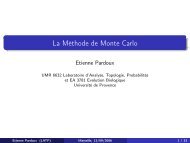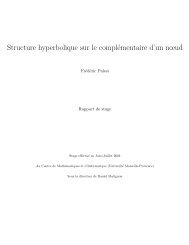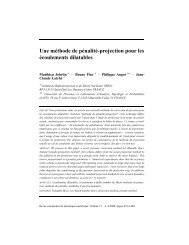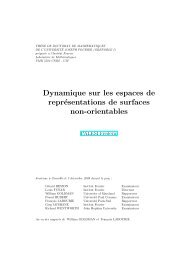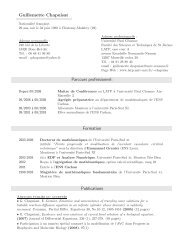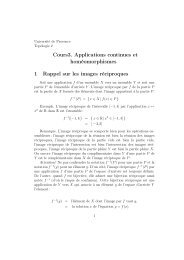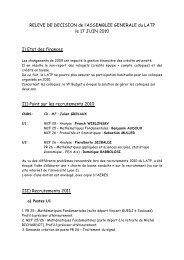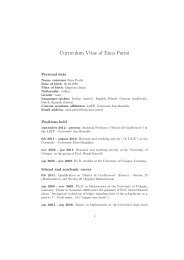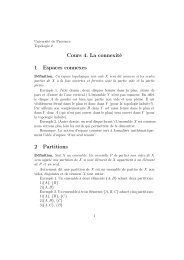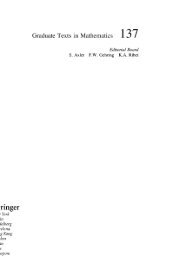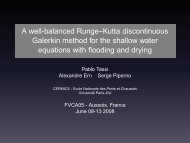RECHERCHE DE MESURES INVARIANTES POUR L'ACTION ...
RECHERCHE DE MESURES INVARIANTES POUR L'ACTION ...
RECHERCHE DE MESURES INVARIANTES POUR L'ACTION ...
You also want an ePaper? Increase the reach of your titles
YUMPU automatically turns print PDFs into web optimized ePapers that Google loves.
[Gil87] Robert H. Gilman. Classes of linear automata. Ergodic Theory Dynam. Systems, 7(1) :105–118,<br />
1987.<br />
[Hed69] Gustav A. Hedlund. Endormorphisms and automorphisms of the shift dynamical system. Math.<br />
Systems Theory, 3 :320–375, 1969.<br />
[HMM03] Bernard Host, Alejandro Maass, and Servet Martínez. Uniform Bernoulli measure in dynamics<br />
of permutative cellular automata with algebraic local rules. Discrete Contin. Dyn. Syst., 9(6) :1423–<br />
1446, 2003.<br />
[Kit87] Bruce P. Kitchens. Expansive dynamics on zero-dimensional groups. Ergodic Theory Dynam.<br />
Systems, 7(2) :249–261, 1987.<br />
[KM00] Petr Kůrka and Alejandro Maass. Limit sets of cellular automata associated to probability<br />
measures. J. Statist. Phys., 100(5-6) :1031–1047, 2000.<br />
[Kůr97] Petr Kůrka. Languages, equicontinuity and attractors in cellular automata. Ergodic Theory<br />
Dynam. Systems, 17(2) :417–433, 1997.<br />
[Led78] François Ledrappier. Un champ markovien peut être d’entropie nulle et mélangeant. C. R. Acad.<br />
Sci. Paris Sér. A-B, 287(7) :A561–A563, 1978.<br />
[Lin84] Douglas A. Lind. Applications of ergodic theory and sofic systems to cellular automata. Phys.<br />
D, 10(1-2) :36–44, 1984.<br />
[Mil88] John Milnor. On the entropy geometry of cellular automata. Complex Systems, 2(3) :357–385,<br />
1988.<br />
[MM98] Alejandro Maass and Servet Martínez. On Cesàro limit distribution of a class of permutative<br />
cellular automata. J. Statist. Phys., 90(1-2) :435–452, 1998.<br />
[Nas95] Masakazu Nasu. Textile systems for endomorphisms and automorphisms of the shift. Mem.<br />
Amer. Math. Soc., 114(546) :viii+215, 1995.<br />
[Piv05] Marcus Pivato. Invariant measures for bipermutative cellular automata. Discrete Contin. Dyn.<br />
Syst., 12(4) :723–736, 2005.<br />
[PY02] Marcus Pivato and Reem Yassawi. Limit measures for affine cellular automata. Ergodic Theory<br />
Dynam. Systems, 22(4) :1269–1287, 2002.<br />
[PY04] Marcus Pivato and Reem Yassawi. Limit measures for affine cellular automata. II. Ergodic Theory<br />
Dynam. Systems, 24(6) :1961–1980, 2004.<br />
[Rud90] Daniel J. Rudolph. ×2 and ×3 invariant measures and entropy. Ergodic Theory Dynam. Systems,<br />
10(2) :395–406, 1990.<br />
[Sab06] Mathieu Sablik. Étude de l’action conjointe d’un automate cellulaire et du décalage : Une approche<br />
topologique et ergodique. PhD thesis, Université de la Méditerranée, Juillet 2006. Mathématiques<br />
et Fondements de l’Informatique.<br />
[Sab07] Mathieu Sablik. Measure rigidity for algebraic bipermutative cellular automata. Ergodic Theory<br />
and Dynamical Systems, (27) :1965–1990, December 2007.<br />
[Sab08] Mathieu Sablik. Directional dynamics for cellular automata : A sensitivity to initial condition<br />
approach. Theoretical Computer Science, 2008.<br />
[Sch95] Klaus Schmidt. Dynamical systems of algebraic origin, volume 128 of Progress in Mathematics.<br />
Birkhäuser Verlag, Basel, 1995.<br />
[She92] Mark A. Shereshevsky. Lyapunov exponents for one-dimensional cellular automata. J. Nonlinear<br />
Sci., 2(1) :1–8, 1992.<br />
[Sil05] Sylvia Silberger. Subshifts of the three dot system. Ergodic Theory Dynam. Systems, 25(5) :1673–<br />
1687, 2005.<br />
[Tis00] Pierre Tisseur. Cellular automata and Lyapunov exponents. Nonlinearity, 13(5) :1547–1560, 2000.<br />
[Wal82] Peter Walters. An introduction to ergodic theory, volume 79 of Graduate Texts in Mathematics.<br />
Springer-Verlag, New York, 1982.<br />
[Wil75] Stephen J. Willson. On the ergodic theory of cellular automata. Math. Systems Theory, 9(2) :132–<br />
141, 1975.<br />
Annexe : Preuve des théorèmes de rigidité 5.4 et 5.5<br />
Dans un soucis d’unité, nous reprenons ici les preuves des théorèmes 5.4 et 5.5 faites dans<br />
[Sab07]<br />
26



